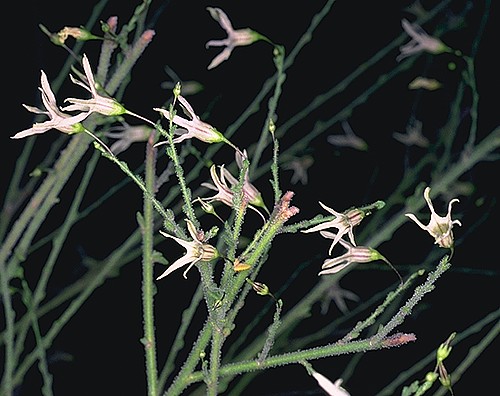
Synonymy
Cyphanthera scabrella (Benth.) Miers, Ann. Mag. Nat. Hist. ser. 2, 11: 380 (1853)
Anthocercis scabrella Benth., in DC., Prodr. 10: 192 (1846).
T: Euroka Creek, Nepean River, Blue Mtns, N.S.W., 1834, R. Cunningham s.n.; holo: K; iso: K.
Description
Erect or scrambling shrub to 1.3 m, grey-green. Branches sparsely to moderately scabrous-tomentose with dendritic and forked, non-glandular hairs and scattered glandular hairs.
Leaves broadly elliptic to broadly ovate, rarely elliptic, almost sessile, mostly 3–7 mm long, 2–4 mm wide, sometimes larger, tomentose.
Flowers solitary or in 1–3–flowered cymes; pedicels 3.5–10 mm long. Calyx 1.5–2.5 mm long, glabrous. Corolla 6.5–11.5 mm long, almost glabrous, creamy-white, often tinged with yellowish-green, the striations purple; lobes linear, 3–6.5 mm long. Stamens 1.5–2 mm long.
Capsule more or less globose, c. 3 mm diam. Seeds 2–2.3 mm long.
Distribution and ecology
An uncommon species endemic in the Blue Mtns of N.S.W. Occurs as small, scattered populations in dry to wet sclerophyll forest, in sandstone soil.
Selected specimens
N.S.W.: Nepean River district, Sept. 1897, W. Forsyth (AD, NSW); c. 80 km NW of Sydney, L. Haegi 1416 (BRI, MEL, NSW).
Derivation of epithet
From scaber, rough or scabrous; the addition of -ellus indicates the diminutive and hence the plant is only somewhat scabrous.
Images and information on web
Further information and images of this species in NSW can be seen on the PlantNET site.
An image of this species can be seen on the Canberra Botanic Gardens site at
http://www.anbg.gov.au/images/photo_cd/732131822180/034.html as Anthocercis scabrella.Pharmacology: A discussion of the tropane alkaloids which occur in Cyphanthera and other Anthocercideae can be found in Griffith & Lin (2000).
Ref: W.J. Griffin & G.D. Lin (2000). Chemotaxonomy and geographical distribution of tropane alkaloids. Phytochemistry 53: 627–628.
Plant status (if any)
Classified as Risk Code 2RC- (Briggs & Leigh, Rare or Threatened Australian Plants, 1995).

